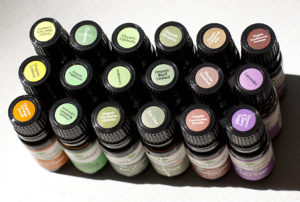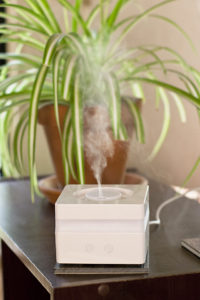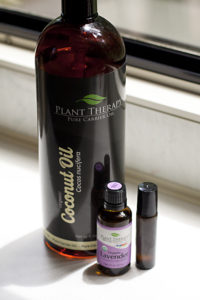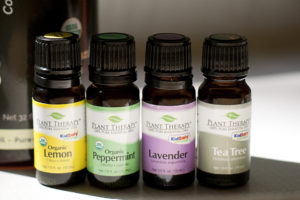Disclaimer: I am not a doctor and this is not medical advice. I’m sharing what has worked for me on my journey using essential oils to support my health.
Since I was little, I have been intrigued with plant medicine. I loved mixing herbs to make my own tonics and beauty products. For the last few years, I have dabbled with essential oils aromatically. This past year I got serious about using them both aromatically and topically to support my health.
What is an essential oil?
An essential oil is a highly concentrated chemical compound that comes from a particular part of a plant. It possesses the odor and other characteristic properties of the plant. The purest oils come from carefully cultivated plants in specific climates and regions of the world. The “essence” of the plants are often obtained through steam distillation or cold pressing methods. These oils are used in aromatherapy, a holistic approach using aromatics to support health of the body, mind, and spirit.

Why use essential oils?
Essential oils naturally contain healing properties. Plants were used as medicine before we had pharmaceuticals. Most of our modern day medicine originates from different types of plants.
Essential oils have analgesic, antibacterial, antidepressant, anti-fungal, anti-inflammatory, antimicrobial, antioxidant, antiseptic, and antiviral properties. They can be calming, cooling, disinfecting, energizing, stimulating, or sedating. Many oils share the same property but one may work better for you than another.
Essential oils can disinfect and clean the air. They can support mood by easing stress or anxiety. Different types of oils can lift spirits, boost energy, and calm the mind. They can promote feelings of tranquility, serenity, and spiritual connectivity.
These oils can support your respiratory system and stimulate your immune system. They can help fight allergies or congestion and open your airways. They can also make a natural bug spray to repel insects.
Essential oils can relieve pain and reduce inflammation. They ease sore muscles and joints. Certain oils support digestive health and can help stomachaches or calm nausea.
Some essential oils support healthy skin and hair by soothing burns, rashes and restoring hair health. They can treat skin conditions like acne or athlete’s foot and help minor wounds. Several oils can be used as a headache remedy.
How to use essential oils
Essential oils can be used two ways: aromatic or topical.
In aromatic use, the oils are dispersed through a diffuser, personal inhaler, or simply by opening a bottle and taking a breath of it. The scent molecules travel from the olfactory nerves directly to the brain. From there they influence the emotional center of the brain and the nervous system.

For topical use, the oils are diluted within a carrier oil. The oil is then applied to the necessary area of skin and absorbed into the body. From there the chemical compounds do their desired healing. Diluting the oils is very important! I cover the process in a section below.

A note on ingesting: There’s a lot of contradicting information out there about ingesting essential oils. I don’t do it. I would be cautious of any source telling you to add drops of oil to a glass of water and then drink it. Essential oils are not water soluable so you’re putting straight oil into your mouth and body. I know some people use vegetable capsules and put oil drops inside them to ingest. I wouldn’t try it without being under a doctor’s supervision.
Where to find pure essential oils?
After listening to Melissa K. Norris’s podcast, Pioneering Today, and hearing about her journey with essential oils, I knew I needed to do more research on the topic. She originally signed on with an MLM company (she never shares which one) to learn more about using essential oils. Norris experienced a lot of misinformation while she was working with the company and after people refused to correct some outright dangerous information she left and stopped using essential oils for a time.
She brought the importance of third party testing to my attention. At the same time I was reading a book (Vitamania by Catherine Price) about how the FDA doesn’t regulate any herbal or dietary supplements. Cosmetics and essential oils fall under that too. So a bottle of oil can say “pure” or “therapeutic grade” but that really doesn’t mean anything. Those labels don’t ensure that it’s free of adulterants or additives. Oils that aren’t pure won’t give the proper health benefits.
When I was starting my path using essential oils I looked at several different companies. All of them claimed to sell pure oils at all kinds of different prices. For me to consider using a company’s oils, they need to publish their GC/MS third party testing policy and results. Quite a few companies do this. Look for companies who properly label their oils with the latin name, origins, and include safe use directions for the product. I recommend doing your own research to find a company that is right for you.
I landed on using Plant Therapy myself. They publish their third party testing results down the batch of oil so you can see exactly what is in your bottle. I try to buy organic whenever possible so I appreciated that they offer an organic line. I felt their pricing was affordable without sacrificing quality. They also have a blog full of valuable information about their essentials oils and how to use them safely.
Proper dilution and care when beginning with essential oils
Essential oils are highly concentrated substances. Some can be used neat, meaning without dilution, but it generally isn’t recommended. By diluting your oils before applying topically, you make them safer and your bottles will last you longer. Essential oils evaporate quickly so using them in a carrier oil makes them more effective as well giving your skin time to absorb them.
Diluting your oils before applying them topically also reduces your risk of sensitization. Sensitization is an allergic immune response that can happen at any time to an essential oil. It most often shows up as a rash (not necessarily even in the area applied) and is a histamine reaction that can worsen over time. Once you’ve developed a sensitization to an oil you likely won’t be able to use it without the symptoms recurring.
I always start with the lowest recommended dilution when making a new roller blend or product. If it isn’t strong enough I can always add more. Plant Therapy has a very helpful Dilution Chart which can be found here.
Recommended dilutions for daily use are 1-2% and for acute situations are 5-10%. That is equivalent to 3-6 drops per 2 tsp (the size of a 10 ml roller bottle) for everyday use. For small areas and acute use it’s 15-30 drops per 2 tsp.
Some Safety Concerns
- If you haven’t used an essential oil before always start with the smallest amount of oil or lowest dilution percentage to see how your body reacts. Avoid using it around your face and other sensitive areas until you’ve tested it.
- Be careful of sun exposure if you’re using citrus oils or other phototoxic ones topically. Your skin can burn where its applied.
- Some oils are not recommended for use on or around children. For any oil, a lower dilution percentage is recommended when applying topically to children.
- You should always be cautious diffusing oils around pets. Most oils are not recommended for topical use on animals. Plant Therapy does have a pup and pony line of oils that is safe for dogs and horses.

Great Starter Oils:
Lavender is basically the catch all oil. It contains most of the properties discussed above and is one of the most functional oils. I use lavender mostly as a calming oil. I rub a roller bottle on my feet before bed to help with a good night’s sleep. When I need to relieve stress, I add it to the diffuser. I even used it for a cut on my face the other day to help disinfect and heal my skin (I rotated it with tea tree oil).
Peppermint helps the respiratory system. I use peppermint for almost everything. It is one of my favorite scents. I use it for my sinuses and allergies. It’s in a spray bottle of it to deter ants. I diffuse it to stimulate alertness. It’s one of the scents I use for gifts of homemade lip balm. We’ve used it to cool fevers. I have a roller bottle blend with eucalyptus and rosemary to help sinuses.
Lemon contains disinfecting power. It is also uplifting for your mood. I use lemon in all my homemade cleaning sprays and I diffuse it in the mornings to clean the air and help me wake up. I combine lemon, lavender, and peppermint in a roller bottle blend to help allergies.
Tea Tree or melaleuca has antibacterial properties. I add it to my cleaning sprays for an extra disinfecting boost. It’s in a roller bottle to apply to any blemishes. I rotated it with lavender the other day to help disinfect and soothe a cut on my face. I add it to a steam inhalation when one of us is feeling sick.
Resources I Find Helpful:
Modern Essentials: The Complete Guide to the Therapeutic Use of Essential Oils
Just the Essentials: How Essential Oils Can Heal Your Skin, Improve Your Health, and Detox Your Life by Adina Grigore
Pioneering Today with Melissa K. Norris – Podcast Episode 110: The Truth About Essential Oils
Do you use essential oils? What are your favorite benefits?


